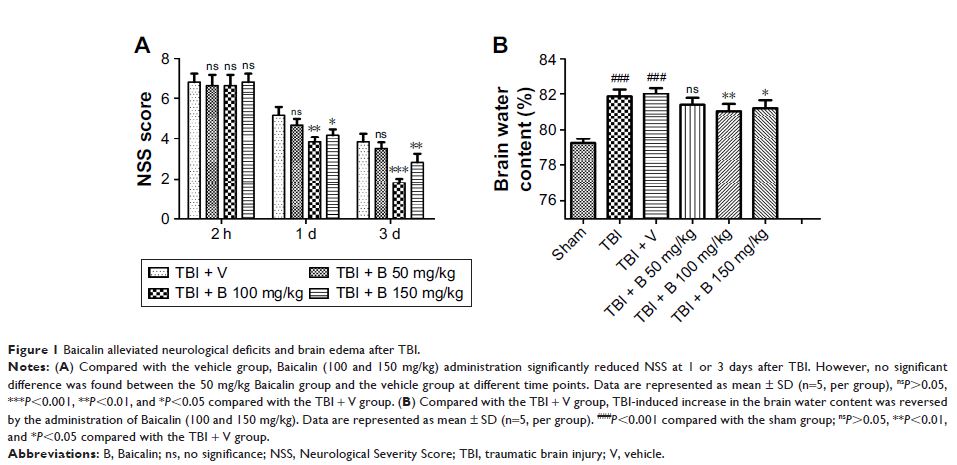9 0 5 7 8
论文已发表
注册即可获取德孚的最新动态
IF 收录期刊
- 2.6 Breast Cancer (Dove Med Press)
- 3.9 Clin Epidemiol
- 3.3 Cancer Manag Res
- 3.9 Infect Drug Resist
- 3.6 Clin Interv Aging
- 4.8 Drug Des Dev Ther
- 2.8 Int J Chronic Obstr
- 8.0 Int J Nanomed
- 2.3 Int J Women's Health
- 3.2 Neuropsych Dis Treat
- 4.0 OncoTargets Ther
- 2.2 Patient Prefer Adher
- 2.8 Ther Clin Risk Manag
- 2.7 J Pain Res
- 3.3 Diabet Metab Synd Ob
- 4.3 Psychol Res Behav Ma
- 3.4 Nat Sci Sleep
- 1.9 Pharmgenomics Pers Med
- 3.5 Risk Manag Healthc Policy
- 4.5 J Inflamm Res
- 2.3 Int J Gen Med
- 4.1 J Hepatocell Carcinoma
- 3.2 J Asthma Allergy
- 2.3 Clin Cosmet Investig Dermatol
- 3.3 J Multidiscip Healthc

黄芩苷通过 Akt/Nrf2 通路在创伤性脑损伤小鼠模型中提供神经保护作用
Authors Fang J, Wang H, Zhou J, Dai W, Zhu Y, Zhou Y, Wang X, Zhou M
Received 28 January 2018
Accepted for publication 30 May 2018
Published 10 August 2018 Volume 2018:12 Pages 2497—2508
DOI https://doi.org/10.2147/DDDT.S163951
Checked for plagiarism Yes
Review by Single-blind
Peer reviewers approved by Dr Linqing Li
Peer reviewer comments 2
Editor who approved publication: Dr Sukesh Voruganti
Background: The neuroprotective effects of Baicalin have been confirmed in
several central nervous system (CNS) diseases. However, its possible effect on
traumatic brain injury (TBI) model is still not clear. The present study is
aimed to investigate the role and the underling mechanisms of 7-d-glucuronic
acid-5,6-dihydroxyflavone (Baicalin) on TBI model.
Methods: The weight-drop model of TBI in Institute of
Cancer Research mice was treated with Baicalin intraperitoneally at
30 minutes after TBI. LY294002 (LY) (a commonly used PI3K/Akt pathway
inhibitor) was injected into the left ventricle at 30 minutes before TBI.
All mice were euthanized at 24 hours after TBI to collect the brain tissue
for a series of tests except for neurological function, which was measured at
2 hours and 1 and 3 days post-TBI.
Results: Baicalin administration significantly improved
neurobehavioral function, alleviated brain edema, and reduced
apoptosis-positive cells by terminal deoxynucleotidyl transferase dUTP nick end
labeling (TUNEL) assay accompanied with the upregulation of B-cell lymphoma 2
(Bcl-2) and downregulation of Bcl-2-associated X protein (Bax) and
cleaved-caspase 3 by Western blot. Besides, TBI-induced oxidant stress status
was also restored in the Baicalin group by measuring malondialdehyde (MDA)
content, glutathione peroxidase (GPx), and superoxide dismutase (SOD) levels in
the injured brain cortex. Furthermore, translocation of Nrf2 to the nucleus was
dramatically enhanced by Baicalin verified by immunofluorescence and Western
blot analyses. Accordingly, its downstream antioxidative enzymes nicotinamide
adenine dinucleotide phosphate:quinine oxidoreductase 1 (NQO-1) and heme
oxygenase 1 (HO-1) were also activated by Baicalin confirmed by quantitative
reverse transcription polymerase chain reaction (RT-qPCR) and Western blot.
However, cotreatment with Baicalin and LY could partly abolish Baicalin-induced
activation of Nrf2 and its neuroprotective effects in TBI.
Conclusion: This study demonstrates that Baicalin provides a
neuroprotective effect in TBI mice model via activating the Akt/Nrf2 pathway.
Keywords: Baicalin,
traumatic brain injury, Akt, nuclear factor erythroid 2-related factor 2,
apoptosis, oxidative stress
